

Inox et biofilm et Salmonella. Inox et biofilm et Listeria. Inox, biofilm et Escherichia coli. WILEY 01/03/18 Bacterial attachment and biofilm formation on stainless steel surface and their in vitro inhibition by marine fungal extracts. This study evaluates anti‐biofilm activity of four extracts from marine fungi; Penicillium citrinum PR1T4, Sarocladium strictum PP2L4, Aspergillus sydowii PR3T13, and Aspergillus spp.
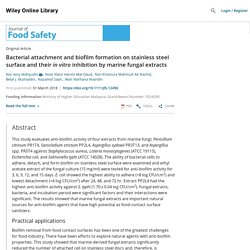
PR5T4 against Staphylococcus aureus, Listeria monocytogenes (ATCC 19115), Escherichia coli, and Salmonella typhi (ATCC 14028). The ability of bacterial cells to adhere, detach, and form biofilm on stainless steel surface were examined and ethyl acetate extract of the fungal culture (15 mg/ml) were tested for anti‐biofilm activity for 3, 6, 9, 12, and 15 days.
E. coli showed the highest ability to adhere (>8 log CFU/cm2) and lowest detachment (<4 log CFU/cm2) after 24, 48, and 72 hr. Extract PP2L4 had the highest anti‐biofilm activity against S. typhi (1.70 ± 0.04 log CFU/cm2). Fungal extracts, bacteria, and incubation period were significant factors and their interactions were significant. Practical applications. Rev. Inst. Med. trop. S. Paulo vol.58 São Paulo 2016 Epub May 24, 2016 BIOFILM FORMATION OF Vibrio cholerae ON STAINLESS STEEL USED IN FOOD PROCESSING. Brief Communication BIOFILM FORMATION OF Vibrio cholerae ON STAINLESS STEEL USED IN FOOD PROCESSING Milagro FERNÁNDEZ-DELGADO1 Héctor ROJAS2 Zoilabet DUQUE3 Paula SUÁREZ4 Monica CONTRERAS1.
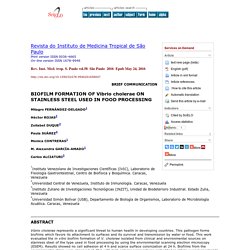
Journal of Food cience and Engineering 6 (2016) 332-343 Antimicrobial Activity of Stainless Steel with a Modified TiN Upperlayer on Meat Related Contaminants. AIMS MICROBIOLOGY 18/08/16 Transfer of bacteria between stainless steel and chicken meat: A CLSM and DGGE study of biofilms. ACS Appl Mater Interfaces. 2018 Jul 11;10(27):22902-22912. Food-Safe Modification of Stainless Steel Food-Processing Surfaces to Reduce Bacterial Biofilms. Biofilm formation on stainless steel (SS) surfaces of food-processing plants, leading to food-borne illness outbreaks, is enabled by the attachment and confinement of pathogens within microscale cavities of surface roughness (grooves, scratches).

We report foodsafe oil-based slippery coatings (FOSCs) for food-processing surfaces that suppress bacterial adherence and biofilm formation by trapping residual oil lubricant within these surface cavities to block microbial growth. SS surfaces were chemically functionalized with alkylphosphonic acid to preferentially wet a layer of food-grade oil. FOSCs reduced the effective surface roughness, the adhesion of organic food residue, and bacteria. FOSCs significantly reduced Pseudomonas aeruginosa biofilm formation on standard roughness SS-316 by 5 log CFU cm–2, and by 3 log CFU cm–2 for mirror-finished SS. FOSCs also enhanced surface cleanability, which we measured by bacterial counts after conventional detergent cleaning. Journal of Food Science and Engineering 6 (2016) 332-343 Antimicrobial Activity of Stainless Steel with a Modified TiN Upperlayer on Meat Related Contaminants.
Tropical Journal of Pharmaceutical Research June 2015; 14 (6): 1075-1079 Effect of Carvacrol on Salmonella Saintpaul Biofilms on Stainless Steel Surface. Mater Sci Eng C Mater Biol Appl. 2015 Jun;51:356-61. Anti-biofilm formation of a novel stainless steel against Staphylococcus aureus. Open Access Abstract.

GLOBAL VETERINARIA - 2010 - Biofilm formation of Escherichia coli O111 on food contact stainless steel and high density polyethylene surfaces. FOOD SAFETY MAGAZINE - APRIL/MAY 2015 - Reduction of Shiga Toxin-Producing Escherichia coli Attached to Stainless Steel. Sanitation | April/May 2015 By Amy R.
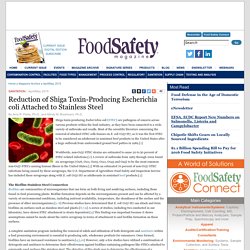
Parks, Ph.D., and Mindy M. Brashears, Ph.D. Shiga toxin-producing Escherichia coli (STEC) are pathogens of concern across various products within the food industry, as they have been connected to a wide variety of outbreaks and recalls. Most of the scientific literature concerning the removal of attached STEC cells focuses on E. coli O157:H7, as it was the first STEC to be considered an adulterant in nonintact beef products in the United States after a large outbreak from undercooked ground beef patties in 1982.[1] Worldwide, non-O157 STEC strains are estimated to cause 20 to 50 percent of STEC-related infections.[2] A review of outbreaks from 1983 through 2002 found six serogroups (O26, O111, O103, O121, O145 and O45) to be the most common non-O157 STECs causing human illness in the United States.[3] With an estimated 70 percent of non-O157 STEC infections being caused by these serogroups, the U.S.
Detergent/Sanitizer Combination Effectiveness. Food Control, 2012, Vol. 25 (1), p. 1-9 Elimination des biofilms de Listeria monocytogenes, Staphylococcus aureus et Escherichia coli O157 : H7 présents sur l'acier inoxydable en utilisant de la poudre de pétoncle. L'adresse du site bibliomer change.

Ciênc. Tecnol. Aliment. vol.32 no.1 Campinas Mar. 2012 Epub Jan 31, 2012 Chemical sanitizers to control biofilms formed by two Pseudomonas species on stainless steel surface. Chemical sanitizers to control biofilms formed by two Pseudomonas species on stainless steel surface Sanificantes químicos no controle de biofilmes formados por duas espécies de Pseudomonas em superfície de aço inoxidável Danila Soares CaixetaI; Thiago Henrique ScarpaII; Danilo Florisvaldo BrugneraI; Dieyckson Osvani FreireI; Eduardo AlvesI; Luiz Ronaldo De AbreuI; Roberta Hilsdorf PiccoliI, * IDepartamento de Ciência dos Alimentos, Universidade Federal de Lavras - UFLA, CEP 37200-000, Lavras, MG, Brazil, e-mail: rhpiccoli@dca.ufla.br IIDepartamento de Fitopatologia, Universidade Federal de Lavras - UFLA, CEP 37200-000, Lavras, MG, Brazil The biofilm formation of Pseudomonas aeruginosa and Pseudomonas fluorescens on AISI 304 stainless steel in the presence of reconstituted skim milk under different temperatures was conducted, and the potential of three chemical sanitizers in removing the mono-species biofilms formed was compared. 1 Introduction.

Brazilian Journal of Microbiology (2010) 41: 97-106 BIOFILM FORMATION BY Listeria monocytogenes ON STAINLESS STEEL SURFACE AND BIOTRANSFER POTENTIAL. BLOG D ALBERT AMGAR 12/10/13 Un exemple de biofilm d’exclusion compétitive de E. coli O157:H7 sur des surfaces en acier inoxydable. L’écologie microbienne dirigée des ateliers de production trouve dans cet article une justification avec l'inactivation de Escherichia coli O157:H7 sur des surfaces en acier inoxydable lors de l'exposition à un biofilm de Paenibacillus polymyxa.
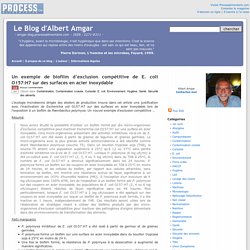
Un nouvel exemple d’exclusion compétitive … Biofilms (2004) 1, 65–73 Combined effect of chelating agents and ultrasound on biofilm removal from stainless steel surfaces. Application to “Escherichia coli milk” and “Staphylococcus aureus milk” biofilms. Arq. Bras. Med. Vet. Zootec. vol.62 no.6 Belo Horizonte Dec. 2010 Controlling Bacillus cereus adherence to stainless steel with different cleaning and sanitizing procedures used in dairy plants. Controlling Bacillus cereus adherence to stainless steel with different cleaning and sanitizing procedures used in dairy plants Controle do processo de adesão de Bacillus cereus ao aço inoxidável após diferentes procedimentos de limpeza e sanitização usados na indústria de laticínios.
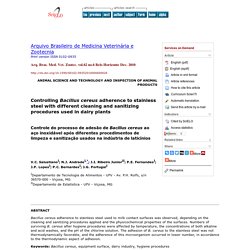
Appl. Environ. Microbiol. January 2005 Biofilm Formation by Escherichia coli O157:H7 on Stainless Steel: Effect of Exopolysaccharide and Curli Production on Its Resistance to Chlorine. Sensitivity of planktonic cells to chlorine.Viability of test strains was not affected by treatment with water.
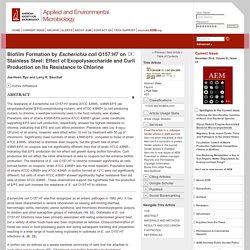
Shown in Fig. 1 are populations of planktonic cells of E. coli O157:H7 strains 43895-EPS, ATCC 43895-, and ATCC 43895+ grown on HLJA at 22 and 12°C and treated with chlorine (10, 25, and 50 μg/ml) for 1, 3, 5, and 10 min. AFRICAN JOURNAL OF MICROBIOLOGY RESEARCH Vol.8(36), pp. 3347-3353 , September 2014 Action of sanitizers on Staphylococcus aureus biofilm on stainless steel and polypropylene surfaces. The interest of researchers in various areas has resulted in the investigation of different biofilm systems using a wide range of techniques. Biofilms are microbial communities consisting of mono or multi-species sessile cells, embedded in a matrix of extracellular polymers (exopolysaccharides-EPS) adhering to surfaces.
In the food industry, the existence of biofilms is quite problematic, being responsible for the economic loss and contamination of food. Consequently, research involving the characterization of the ability of microbial biofilm formation is relevant for the subsequent studies using sanitizing and antibiotic agents for prevention or remediation of surfaces with already formed biofilms. Key words: Antimicrobial effect, microorganism, Syzygium aromaticum, Thymus vulgaris. Microorganisms have been evolving for approximately 4 billion years, and up to 2 billion years ago they were the only life forms on Earth.